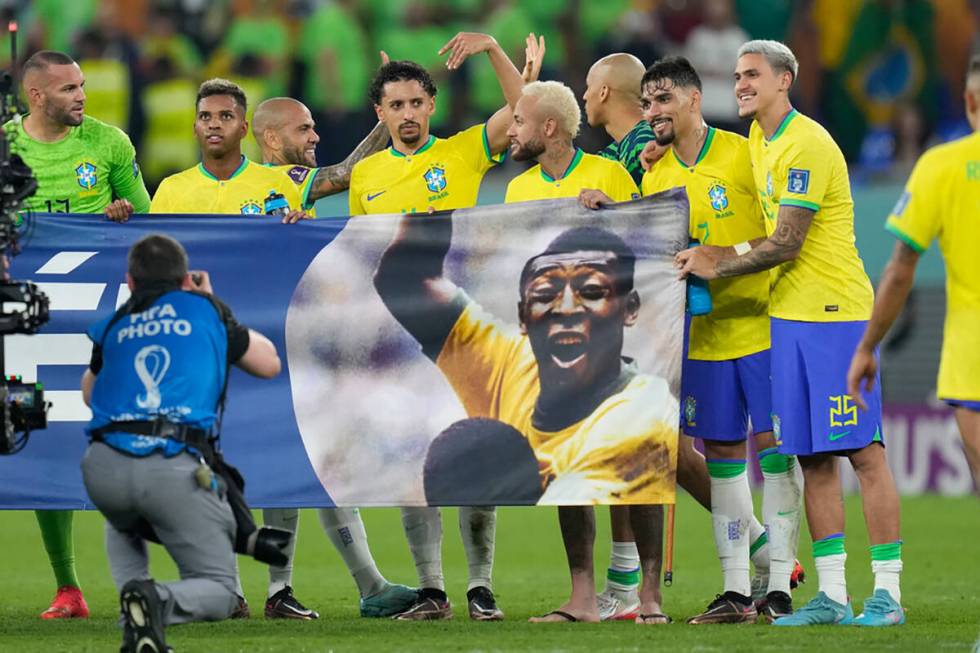Remembering when Pele hit the jackpot in Las Vegas

His birth name was Edson Arantes do Nascimento. The rest of the world knows him as Pele, the greatest soccer player who ever lived.
You may have read that he will be spending Christmas in the hospital due to complications from colon cancer that have compromised his heart and kidneys. He’s 82 now. The prognosis is not so good.
Pele — he said he was given the nickname as a youngster for the way he mispronounced the name of a favorite player, a goalkeeper named Bile — scored 1,279 goals in 1,363 games. Seventy-seven came in international play for Brazil, which he led to World Cup titles in 1958, 1962 and 1970.
His skills with the spotted ball were so extraordinary that in 1967, the warring nations of Nigeria and Biafra declared a two-day truce so they could watch him play an exhibition match.
By then, Pele was much more than a great soccer player. He had become a world treasure.
In 1999, he made Time magazine’s 100 Persons of the Century. The only other athletes so honored: Muhammad Ali and Jackie Robinson.
Having said all of that, there are taxi drivers and valet parking attendants in Las Vegas who will have you believe you really haven’t made it, at least not here, until they put your name on a marquee.
Or your face on a slot machine.
Pele pulls the handle
That is how I came to interview Pele. It happened in 2004, during the Global Gaming Expo at the Convention Center, where one-armed bandits bearing his likeness were introduced.
Pele was wearing a pale green polyester leisure suit. He was 64 then. He still looked fit.
People of all creeds and colors had come to greet him. They pumped his hand, slapped him on the back, hugged him, kissed his cheeks.
When it was my turn, I offered my hand. He brushed it aside and put me in a bear hug. This is how Pele greets strangers, one of his associates said.
Fearing that any significant movement by Pele would cause a seismic shift of mankind that could shake the Convention Center from its foundation, I was asked to interview him in a tiny space in front of the slot machines that were clanging and whistling like English football supporters.
My first question: Did he ever grow tired of this — of being Pele, ambassador of “The Beautiful Game,” as he called his beloved futebol, and a global treasure.
“My first World Cup, I was 17 years old,” he said in halting English about being forever linked with the quadrennial rite of passage. “From then, until now, I keep doing the same. I thank God for that.”
He mentioned having once played in Las Vegas, for the New York Cosmos against the short-lived Quicksilvers of the North American Soccer League.
“It has been been 25 years since I stopped to play. But it looks like I still play today,” he said of his enduring popularity, even in a country where soccer remains a niche pastime instead of a national obsession. “It looks like I scored the (winning) goal yesterday.”
Sublime first touch
As chats go, mine with Pele was brief.
That hardly seemed to matter to a woman speaking Spanish or Portuguese who approached afterward. She was clutching a baby boy and sobbing. She reached for my hand. I was told she wanted me to touch her baby, because Pele had touched me.
I had come to interview a sporting legend. I departed an unwitting participant in a kinetic energy experiment.
Such is the magnetism of Pele.
It has been 18 years since the smiling man wearing the pale green leisure suit gave me a bro hug years before NFL Commissioner Roger Goodell began to awkwardly administer them on draft day. But I will always remember the last thing he said.
When asked about his legacy, he spoke not of scoring goals in the World Cup, but of playing for fun on the dusty and pockmarked pitches of his youth.
“I was born on that,” he said. “I want to die on that.”
It’s the first thing that came to mind when I read that Pele, the greatest soccer player who ever lived, ambassador of The Beautiful Game and world treasure, would be spending Christmas in the hospital, surrounded by his family.
He should be back on the pitch.
Contact Ron Kantowski at rkantowski@reviewjournal.com or 702-383-0352. Follow @ronkantowski on Twitter.